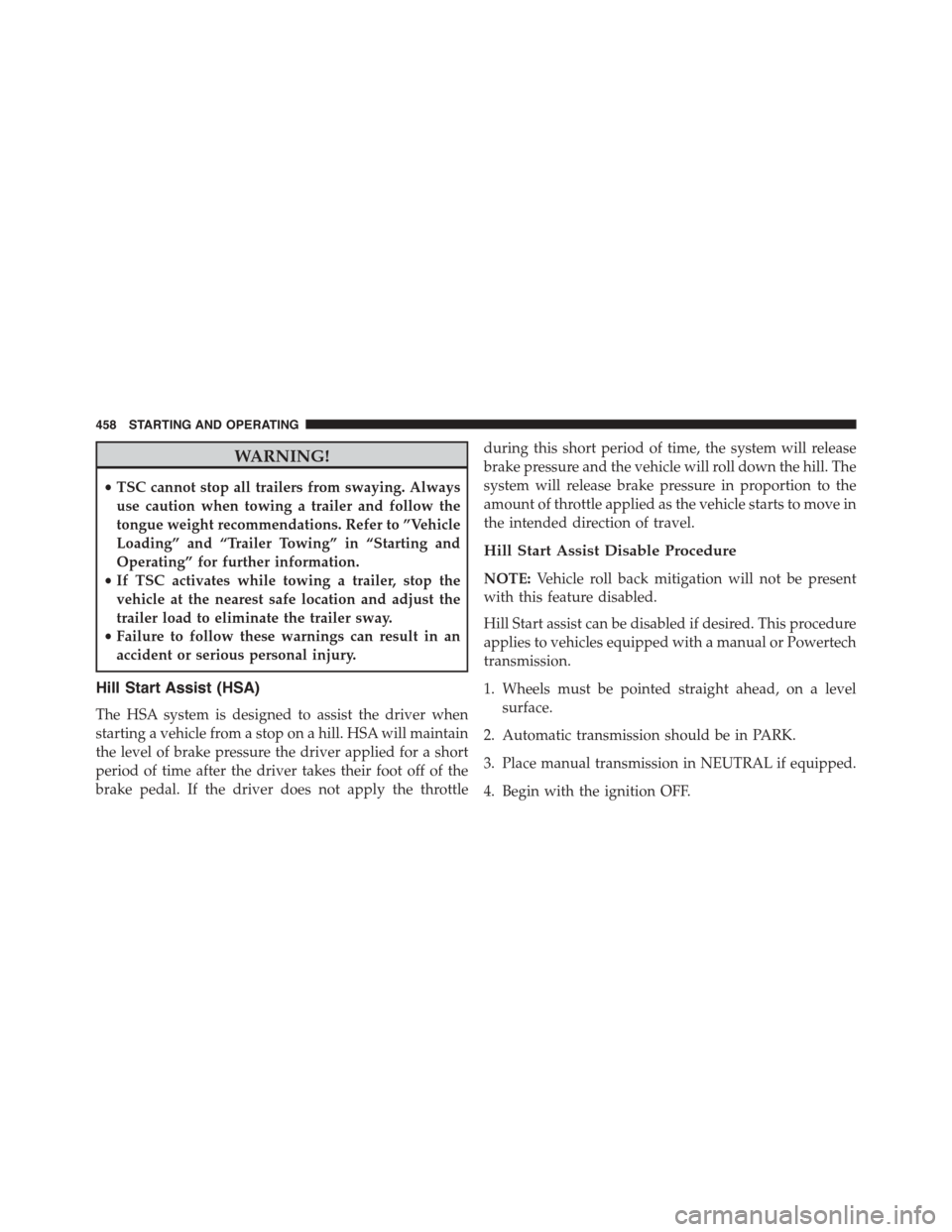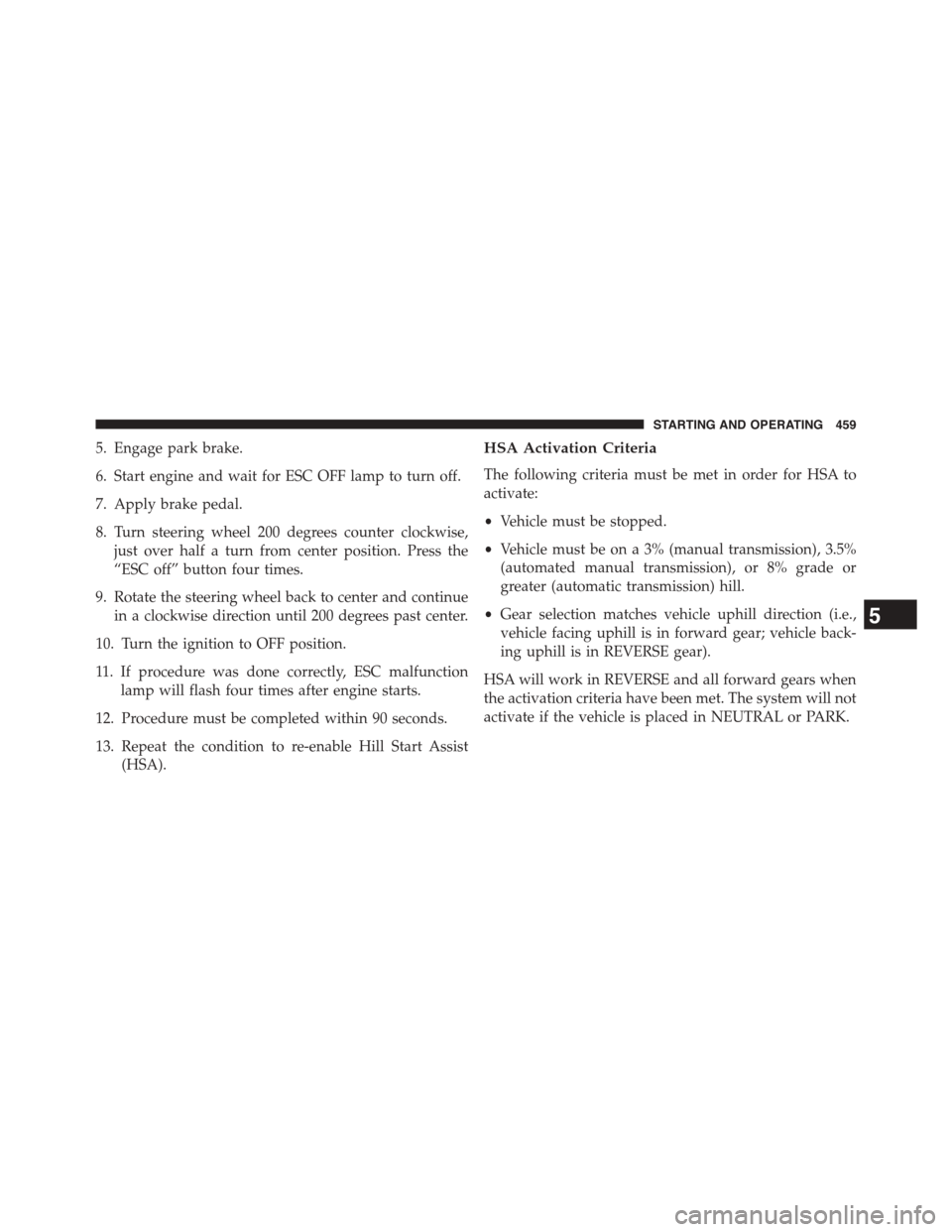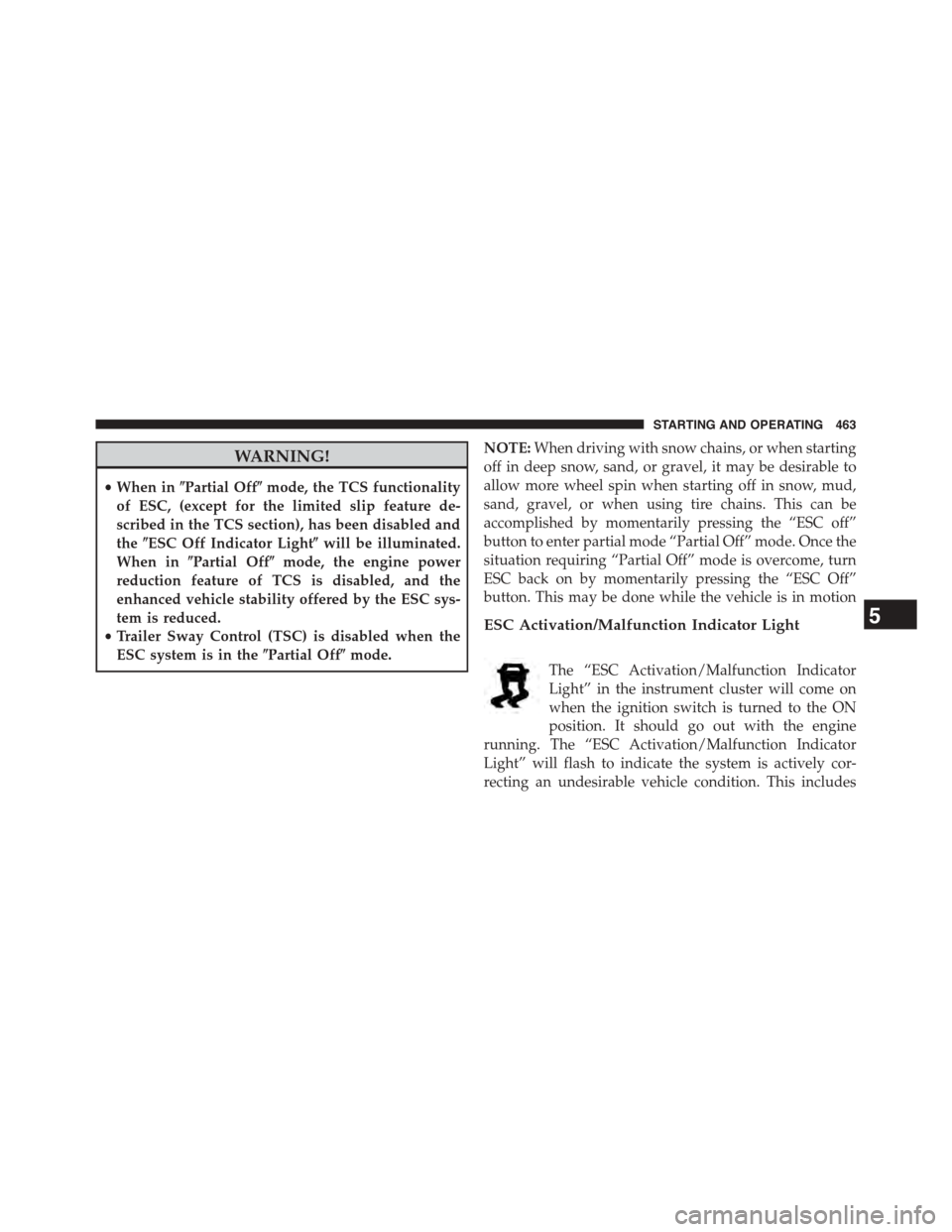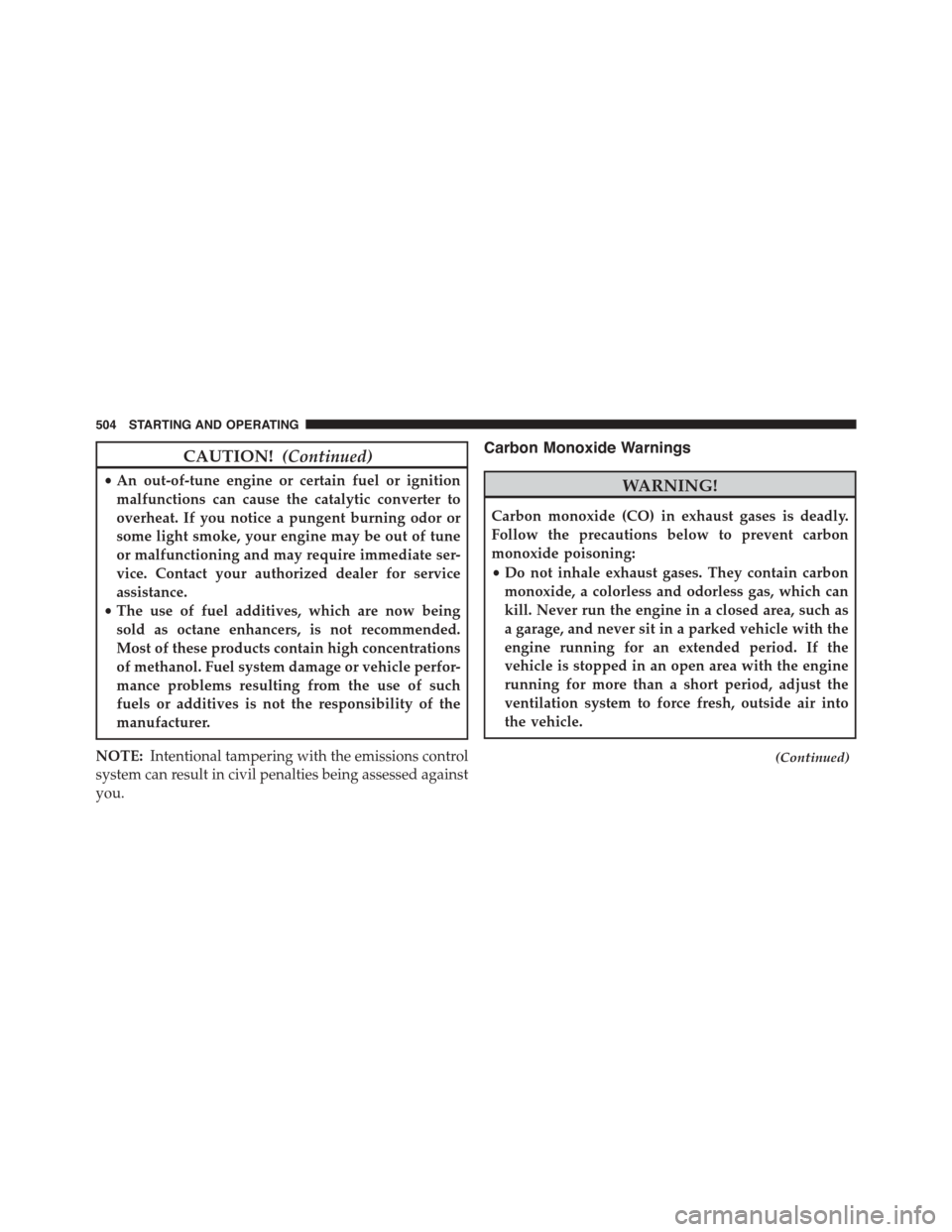ignition DODGE DART 2015 PF / 1.G Owners Manual
[x] Cancel search | Manufacturer: DODGE, Model Year: 2015, Model line: DART, Model: DODGE DART 2015 PF / 1.GPages: 664, PDF Size: 16.96 MB
Page 460 of 664

WARNING!
•TSC cannot stop all trailers from swaying. Always
use caution when towing a trailer and follow the
tongue weight recommendations. Refer to ”Vehicle
Loading” and “Trailer Towing” in “Starting and
Operating” for further information.
•If TSC activates while towing a trailer, stop the
vehicle at the nearest safe location and adjust the
trailer load to eliminate the trailer sway.
•Failure to follow these warnings can result in an
accident or serious personal injury.
Hill Start Assist (HSA)
The HSA system is designed to assist the driver when
starting a vehicle from a stop on a hill. HSA will maintain
the level of brake pressure the driver applied for a short
period of time after the driver takes their foot off of the
brake pedal. If the driver does not apply the throttle
during this short period of time, the system will release
brake pressure and the vehicle will roll down the hill. The
system will release brake pressure in proportion to the
amount of throttle applied as the vehicle starts to move in
the intended direction of travel.
Hill Start Assist Disable Procedure
NOTE:Vehicle roll back mitigation will not be present
with this feature disabled.
Hill Start assist can be disabled if desired. This procedure
applies to vehicles equipped with a manual or Powertech
transmission.
1. Wheels must be pointed straight ahead, on a level
surface.
2. Automatic transmission should be in PARK.
3. Place manual transmission in NEUTRAL if equipped.
4. Begin with the ignition OFF.
458 STARTING AND OPERATING
Page 461 of 664

5. Engage park brake.
6. Start engine and wait for ESC OFF lamp to turn off.
7. Apply brake pedal.
8. Turn steering wheel 200 degrees counter clockwise,
just over half a turn from center position. Press the
“ESC off” button four times.
9. Rotate the steering wheel back to center and continue
in a clockwise direction until 200 degrees past center.
10. Turn the ignition to OFF position.
11. If procedure was done correctly, ESC malfunction
lamp will flash four times after engine starts.
12. Procedure must be completed within 90 seconds.
13. Repeat the condition to re-enable Hill Start Assist
(HSA).
HSA Activation Criteria
The following criteria must be met in order for HSA to
activate:
•Vehicle must be stopped.
•Vehicle must be on a 3% (manual transmission), 3.5%
(automated manual transmission), or 8% grade or
greater (automatic transmission) hill.
•Gear selection matches vehicle uphill direction (i.e.,
vehicle facing uphill is in forward gear; vehicle back-
ing uphill is in REVERSE gear).
HSA will work in REVERSE and all forward gears when
the activation criteria have been met. The system will not
activate if the vehicle is placed in NEUTRAL or PARK.
5
STARTING AND OPERATING 459
Page 465 of 664

WARNING!
•When in%Partial Off%mode, the TCS functionality
of ESC, (except for the limited slip feature de-
scribed in the TCS section), has been disabled and
the%ESC Off Indicator Light%will be illuminated.
When in%Partial Off%mode, the engine power
reduction feature of TCS is disabled, and the
enhanced vehicle stability offered by the ESC sys-
tem is reduced.
•Trailer Sway Control (TSC) is disabled when the
ESC system is in the%Partial Off%mode.
NOTE:When driving with snow chains, or when starting
off in deep snow, sand, or gravel, it may be desirable to
allow more wheel spin when starting off in snow, mud,
sand, gravel, or when using tire chains. This can be
accomplished by momentarily pressing the “ESC off”
button to enter partial mode “Partial Off” mode. Once the
situation requiring “Partial Off” mode is overcome, turn
ESC back on by momentarily pressing the “ESC Off”
button. This may be done while the vehicle is in motion
ESC Activation/Malfunction Indicator Light
The “ESC Activation/Malfunction Indicator
Light” in the instrument cluster will come on
when the ignition switch is turned to the ON
position. It should go out with the engine
running. The “ESC Activation/Malfunction Indicator
Light” will flash to indicate the system is actively cor-
recting an undesirable vehicle condition. This includes
5
STARTING AND OPERATING 463
Page 466 of 664

Yaw control, traction control, and trailer sway control. If
the lamp remains solid under normal driving conditions,
your vehicle should be serviced at an authorized dealer.
The “ESC Activation/Malfunction Indicator Light” starts
to flash as soon as the tires lose traction and the ESC
system becomes active.
The “ESC Activation/Malfunction Indicator Light” also
flashes when the Traction Control System (TCS) or trailer
sway is active. If the “ESC Activation/ Malfunction
Indicator Light” begins to flash during acceleration, ease
up on the accelerator and apply as little throttle as
possible. Be sure to adapt your speed and driving to the
prevailing road conditions.
NOTE:
•The “ESC Off Indicator Light” and the “ESC
Activation/Malfunction Indicator Light” come on mo-
mentarily each time the ignition switch is turned ON.
•Each time the ignition is turned ON, the ESC system
will be ON even if it was turned off previously.
•The ESC system may make buzzing or clicking sounds
when it is active. This is normal; the sounds will stop
when ESC becomes inactive following the maneuver
that caused the ESC activation.
ESC Off Indicator Light
The “ESC OFF Indicator Light” indicates the
Electronic Stability Control (ESC) is partially
off.
In some cases, when accelerating from stop on steep
grades, it may be beneficial to turn off ESC. Once the
grade ascent is complete, ESC can be turned on again.
464 STARTING AND OPERATING
Page 497 of 664

Tire Pressure Monitoring Low Pressure Warnings
The Tire Pressure Monitoring Telltale Light will illumi-
nate in the instrument cluster, a#LOW TIRE PRESSURE#
message and “Inflate Tire to XX” message will be dis-
played for a minimum of five seconds, and an audible
chime will be activated when one or more of the four
active road tire pressures are low. Should this occur, you
should stop as soon as possible, check the inflation
pressure of each tire on your vehicle, and inflate each tire
to the vehicle’s recommended cold placard pressure
value. The recommended cold placard pressure value is
the pressure value in the#Inflate Tire to XX#message
displayed in the EVIC/DID. The system will automati-
cally update and the Tire Pressure Monitoring Light will
extinguish and the#LOW TIRE PRESSURE#and “Inflate
Tire to XX” messages will turn off once the updated tire
pressures have been received. The vehicle may need to be
driven for up to 20 minutes above 15 mph (24 km/h) to
receive this information.
Service TPMS Warnings
The Tire Pressure Monitoring Telltale Light will flash on
and off for 75 seconds and then remain on solid when a
system fault is detected. The system fault will also sound
a chime and display a “SERVICE TPM SYSTEM” mes-
sage for a minimum of five seconds. If the ignition key is
cycled, this sequence will repeat providing the system
fault still exists. The Tire Pressure Monitoring Telltale
Light will turn off when the fault condition no longer
exists. A system fault can occur with any of the following
scenarios:
1. Jamming due to electronic devices or driving next to
facilities emitting the same radio frequencies as the
TPM sensors.
2. Installing some form of aftermarket window tinting
that affects radio wave signals.
3. Snow or ice around the wheels or wheel housings.
5
STARTING AND OPERATING 495
Page 498 of 664

4. Using tire chains on the vehicle.
5. Using wheels/tires not equipped with TPM sensors.
NOTE:Your vehicle is equipped with a compact spare
wheel and tire assembly.
1. The compact spare tire does not have a tire pressure
monitoring sensor. Therefore, the TPMS will not moni-
tor the tire pressure in the compact spare tire.
2. If you install the compact spare tire in place of a road
tire that has a pressure below the low-pressure warn-
ing limit, upon the next ignition key cycle, a chime will
sound and the Tire Pressure Monitoring Telltale Light
and#LOW TIRE PRESSURE#and “Inflate Tire to XX”
messages will still turn ON due to the low tire.
3. However, after driving the vehicle for up to 20 min-
utes above 15 mph (24 km/h), the Tire Pressure
Monitoring Telltale Light will flash on and off for 75
seconds and then remain on solid and a “SERVICE
TPM SYSTEM” message will be displayed for a mini-
mum of five seconds.
4. For each subsequent ignition key cycle, a chime will
sound and the Tire Pressure Monitoring Telltale Light
will flash on and off for 75 seconds and then remain on
solid and a “SERVICE TPM SYSTEM” message will be
displayed for a minimum of five seconds.
5. Once you repair or replace the original road tire and
reinstall it on the vehicle in place of the compact spare
tire, the TPMS will update automatically and the Tire
Pressure Monitoring Telltale Light will turn OFF, as
long as no tire pressure is below the low-pressure
warning limit in any of the four active road tires. The
vehicle may need to be driven for up to 20 minutes
above 15 mph (24 km/h) in order for the TPMS to
receive this information.
496 STARTING AND OPERATING
Page 499 of 664

Premium System — If Equipped
The TPMS uses wireless technology with wheel rim
mounted electronic sensors to monitor tire pressure lev-
els. Sensors, mounted to each wheel as part of the valve
stem, transmit tire pressure readings to the receiver
module.
NOTE:It is particularly important for you to check the
tire pressure in all of your tires regularly and to maintain
the proper pressure.
The TPMS consists of the following components:
•Receiver Module
•Four Tire Pressure Monitoring Sensors
•Various Tire Pressure Monitoring System Messages,
which display in the Electronic Vehicle Information
Center (EVIC) or Driver Information Display (DID)
•Tire Pressure Monitoring Telltale Light
Tire Pressure Monitoring Low Pressure Warnings
The Tire Pressure Monitoring Telltale Light will illumi-
nate in the instrument cluster and an audible chime will
be activated when one or more of the four active road tire
pressures are low. The audible chime will sound once
every ignition cycle for the first condition that it detects.
In addition, the EVIC/DID will display a “Inflate Tire to
XX” message for a minimum of five seconds and a
graphic of the pressure value(s) with the low tire(s)
displayed in a different color. The recommended cold
placard pressure inflation value is the pressure value
displayed in the#Inflate Tire to XX#message displayed in
the EVIC/DID.
Should a low tire condition occur on any of the four
active road tire(s), you should stop as soon as possible
and inflate all tires that are in a different color on the
5
STARTING AND OPERATING 497
Page 500 of 664

graphic display to the vehicle’s recommended cold plac-
ard pressure value. The system will automatically up-
date, the “Inflate Tire to XX” message will no longer be
displayed, the graphic display of the pressure value(s)
will return to their normal color, and the Tire Pressure
Monitoring Light will extinguish once the updated tire
pressure(s) have been received. The vehicle may need to
be driven for up to 20 minutes above 15 mph (24 km/h)
to receive this information.
Service TPMS Message
The Tire Pressure Monitoring Telltale Light will flash on
and off for 75 seconds, and then remain on solid when a
system fault is detected. The system fault will also sound
a chime. The EVIC/DID will display a “SERVICE TPM
SYSTEM” message for a minimum of five seconds. This
text message is then followed by a graphic display, with
“- -“ in place of the pressure value(s) indicating which
Tire Pressure Monitoring Sensor(s) is not being received.
If the ignition key is cycled, this sequence will repeat,
providing the system fault still exists. If the system fault
no longer exists, the Tire Pressure Monitoring Telltale
Light will no longer flash, the#SERVICE TPM SYSTEM#
message will not be present, and a pressure value will be
displayed instead of dashes. A system fault can occur
with any of the following scenarios:
1. Jamming due to electronic devices or driving next to
facilities emitting the same radio frequencies as the
TPM sensors.
2. Installing some form of aftermarket window tinting
that affects radio wave signals.
3. Snow or ice around the wheels or wheel housings.
4. Using tire chains on the vehicle.
5. Using wheels/tires not equipped with TPM sensors.
498 STARTING AND OPERATING
Page 501 of 664

NOTE:Your vehicle is equipped with a compact spare
wheel and tire assembly.
1. The compact spare tire does not have a tire pressure
monitoring sensor. Therefore, the TPMS will not moni-
tor the tire pressure in the compact spare tire.
2. If you install the compact spare tire in place of a road
tire that has a pressure below the low-pressure warn-
ing limit, upon the next ignition key cycle, a chime will
sound and the Tire Pressure Monitoring Telltale Light
will still turn ON due to the low tire. The “Inflate Tire
to XX” message and the graphic with the low tire
pressure in a different color will be displayed.
3. However, after driving the vehicle for up to 20 min-
utes above 15 mph (24 km/h), the Tire Pressure
Monitoring Telltale Light will flash on and off for 75
seconds and then remain on solid. In addition, the
EVIC/DID will display a “SERVICE TPM SYSTEM”
message for a minimum of five seconds and then
display dashes (- -) in place of the pressure values.
4. For each subsequent ignition key cycle, a chime will
sound and the Tire Pressure Monitoring Telltale Light
will flash on and off for 75 seconds and then remain on
solid, the EVIC/DID will display a “SERVICE TPM
SYSTEM” message for a minimum of five seconds and
then display dashes (- -) in place of the pressure
values.
5. Once you repair or replace the original road tire and
reinstall it on the vehicle in place of the compact spare
tire, the TPMS will update automatically and the Tire
Pressure Monitoring Telltale Light will turn OFF, as
long as no tire pressure is below the low-pressure
warning limit in any of the four active road tires. The
vehicle may need to be driven for up to 20 minutes
above 15 mph (24 km/h) in order for the TPMS to
receive this information.
5
STARTING AND OPERATING 499
Page 506 of 664

CAUTION!(Continued)
•An out-of-tune engine or certain fuel or ignition
malfunctions can cause the catalytic converter to
overheat. If you notice a pungent burning odor or
some light smoke, your engine may be out of tune
or malfunctioning and may require immediate ser-
vice. Contact your authorized dealer for service
assistance.
•The use of fuel additives, which are now being
sold as octane enhancers, is not recommended.
Most of these products contain high concentrations
of methanol. Fuel system damage or vehicle perfor-
mance problems resulting from the use of such
fuels or additives is not the responsibility of the
manufacturer.
NOTE:Intentional tampering with the emissions control
system can result in civil penalties being assessed against
you.
Carbon Monoxide Warnings
WARNING!
Carbon monoxide (CO) in exhaust gases is deadly.
Follow the precautions below to prevent carbon
monoxide poisoning:
•Do not inhale exhaust gases. They contain carbon
monoxide, a colorless and odorless gas, which can
kill. Never run the engine in a closed area, such as
a garage, and never sit in a parked vehicle with the
engine running for an extended period. If the
vehicle is stopped in an open area with the engine
running for more than a short period, adjust the
ventilation system to force fresh, outside air into
the vehicle.
(Continued)
504 STARTING AND OPERATING